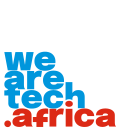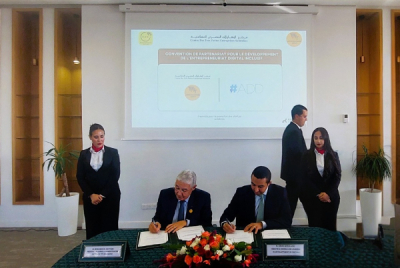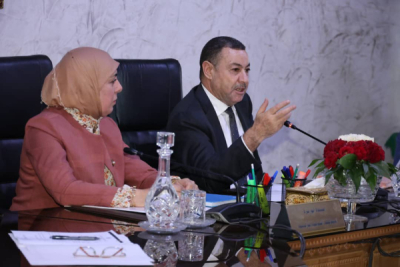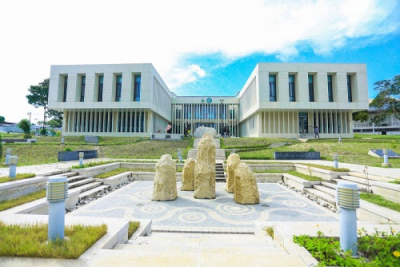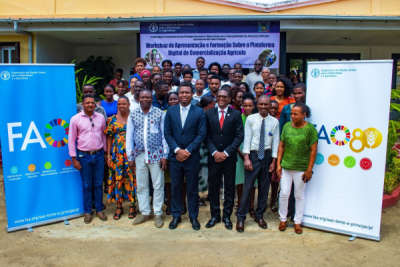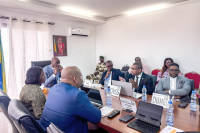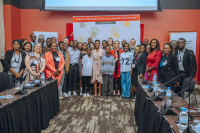
Tech (1090)
-
The 2026–2030 strategy aims to build an inclusive and competitive e-commerce sector.
-
It targets women, youth, and small traders through digital integration and job creation.
-
Implementation faces challenges including low Internet access and financial inclusion.
The Mauritanian government, through the Ministry of Digital Transformation, Innovation and Administrative Modernization and with support from German cooperation agency GIZ, officially approved its National E-commerce Strategy 2026–2030 on Tuesday, October 28. The plan marks a key milestone toward developing a more inclusive, sustainable, and competitive digital economy.
The roadmap seeks to improve access for women entrepreneurs to online markets, create jobs for young people through freelancing and digital platforms, integrate small traders into the formal economy via digitization, and enhance government tax revenues through better transaction traceability. These goals are built on an emerging market where Internet penetration reached 37.4% in 2025.
The strategy comes amid a period of rapid digital transformation, with Africa’s e-commerce market expected to grow by 105% by 2030—from $55 billion to $112.73 billion—according to TechCabal Insights. Mauritania aims to leverage this momentum to strengthen its competitiveness and position its economy within regional digital value chains.
Success will depend on the country’s ability to overcome key structural challenges, including uneven mobile and Internet coverage, reliance on cash payments, and low banking penetration. According to UNCTAD, financial inclusion in Mauritania remains limited to 20.9%, with notable disparities between women (15.5%) and youth (13.1%).
The strategy aims to create a favorable environment for the growth of national e-commerce by promoting digital inclusion, expanding access to online platforms for marginalized economic actors, improving financial transparency, and increasing public revenues through formalized trade. Ultimately, it seeks to build a structured and competitive e-commerce ecosystem capable of supporting sustainable growth.
- Senegal launches 2025 Gov’athon to modernize public administration digitally
- Over 2,000 participants submitted 812 innovation projects for selection
- Hackathon supports national tech goals under 2025 “New Technological Deal”
The Senegalese government launched the second edition of Gov’athon, a national hackathon dedicated to digitally modernizing public administration, in Dakar on Friday, Oct. 24.
The initiative marks an important step in identifying and supporting practical solutions to improve public service efficiency and promote citizen-driven innovation.
The 2025 edition drew a strong response, with 812 projects submitted over 10 days by more than 2,000 participants from academic, entrepreneurial, and civic backgrounds. A total of 104 projects advanced to the final phase , 72 in the Student category, 11 in Startups, and 21 in Citizens.
The final round, scheduled for December, will follow an intensive mentoring and training program to help refine the shortlisted projects. A panel of experts will then select the winning teams in the Student and Startup categories. The winners will receive tailored support to transform their prototypes into operational tools for public administration.
Gov’athon is part of Senegal’s “New Technological Deal”, a national strategy launched in February 2025 to position the country as a leading player in Africa’s digital economy by 2034. The plan targets the creation of 500 certified startups, the training of 100,000 young people in digital professions, and a 95% connectivity rate.
The 2024 edition produced several high-impact projects, including AI Karangué, Firndé Bi, and Agri-Drone Vision, which received awards of 20, 10, and 5 million CFA francs, respectively. These projects highlighted Gov’athon’s key role in modernizing public administration and promoting local digital innovation in education, health, and agriculture.
With this new edition, the government aims to deepen the connection between citizen innovation and public governance while supporting homegrown tech entrepreneurship. The initiative is expected to make public services more efficient, accessible, and aligned with user needs.
Samira Njoya
- Morocco signs deal to boost inclusive digital entrepreneurship in Rabat-Salé-Kénitra
- Partnership supports startups via training, infrastructure, and strategic guidance
- Initiative aligns with “Digital Morocco 2030” goals of jobs, exports, and innovation
Morocco's Digital Development Agency (ADD) and the Management Association of the Center for Solidarity-Based Very Small Enterprises (CTPES) signed a partnership agreement on Monday, Oct. 27, in Salé to promote innovation and inclusive digital entrepreneurship.
The agreement focuses on the Rabat-Salé-Kénitra region and will be implemented through the Digital Solidarity Incubator (IDS).
Under the partnership, the two organizations plan to pool resources and expertise to support high-potential project leaders. They will ensure access to the IDS infrastructure, including its FabLab, provide technical and strategic support to digital startups, offer targeted training, and integrate supported projects into digital systems and platforms developed by the ADD.
The collaboration aligns with the "Digital Morocco 2030" strategy, the kingdom's roadmap for digital transformation. That plan aims to create 3,000 certified startups by 2030, mobilize 7 billion dirhams (about $758 million) in funding, and generate 240,000 direct jobs in the sector. It also targets raising digital exports to 40 billion dirhams by 2030, up from 13.4 billion dirhams recorded in the first quarter of the current year.
The partnership comes amid a dynamic entrepreneurial context. In the Rabat-Salé-Kénitra region, 6,399 companies were created during the first seven months of 2024, according to the Moroccan Office of Industrial and Commercial Property (OMPIC).
Nationally, Morocco's startup ecosystem is also progressing. The country ranks 88th globally and ninth in Africa in the Global Startup Ecosystem Index 2025 by U.S. consultancy StartupBlink, with growth estimated at 23% in 2025.
Beyond supporting entrepreneurship, the agreement marks a significant step in regionalizing the national digital policy. By connecting support mechanisms with young project leaders and local stakeholders, the initiative aims to boost digital inclusion, foster value creation, and encourage the emergence of a regional entrepreneurial base capable of contributing sustainably to Morocco's economic growth.
Samira Njoya
- Algeria launches expert digitalization committee to guide national tech policies
- Committee supports “Digital Algeria 2030” goals with expert recommendations
- Strategy targets 500,000 ICT jobs, 20% GDP from digital economy
The Algerian government, on Oct. 23, 2025, officially launched the Scientific and Technical Committee of the High Commission for Digitalization (CSTHCN) in Algiers. The new advisory body will help guide the country’s national digital policies.
Meriem Benmouloud, the High Commissioner for Digitalization, hosted the ceremony and described the committee as a new milestone in Algeria’s digital transformation, part of the structured process leading to the “Digital Algeria 2030” vision.
The 15-member committee, including three experts from the Algerian diaspora, brings together specialists in information technology, artificial intelligence, mathematics, economics, and financial systems. Its main tasks include providing recommendations, reviewing draft legislation and regulations on digitalization, and conducting research to anticipate technological trends and their economic impacts.
The committee’s creation marks the final step in establishing the High Commission for Digitalization, which was set up in 2023 to spearhead the nation’s digital transformation.
Two years later, the “Digital Algeria 2030” strategy has been finalized and is expected to begin implementation soon. The plan aims to train 500,000 ICT specialists, connect all public institutions, and raise the digital economy’s contribution to 20% of GDP by 2030.
Digital technology is playing an increasingly central role in Algeria’s economy. While the potential is significant, analysts point to a gap between major investments and tangible returns, highlighting the need for stronger oversight.
Through this committee, Algeria aims to accelerate the implementation of its digital policies, improve public service efficiency, promote digital inclusion, and unlock greater economic value from the sector.
Samira Njoya
-
The University of Dar es Salaam (UDSM) has digitized over 1,000 online courses accessible to 39,000 students across multiple campuses.
-
The initiative is part of the Higher Education for Economic Transformation (HEET) program, which is over 80% implemented.
-
UDSM’s digital infrastructure now includes a 10 Gbps high-speed network to support hybrid and remote learning.
Tanzania is accelerating the integration of information and communication technologies (ICT) to drive socio-economic development, with education at the forefront of this shift.
Speaking at a meeting with the Tanzania Editors Forum in Dar es Salaam on October 21, William A. L. Anangisye, Vice-Chancellor of the University of Dar es Salaam (UDSM), said the Higher Education for Economic Transformation (HEET) program represents a new stage in higher education reform.
Already more than 80% implemented, HEET aims to make digitalization a strategic tool for academic competitiveness and innovation.
The project reached a milestone with the launch of more than 1,000 digital courses, now available to 39,000 students across UDSM campuses in Dar es Salaam, Lindi, Kagera, and Zanzibar.
This digital offering relies on a 10 Gbps broadband infrastructure designed to support hybrid learning platforms and strengthen remote teaching capabilities.
Liberato Haule, Deputy Coordinator of the program, said the infrastructure “modernizes learning environments and enhances partnerships between universities and businesses.”
HEET, funded by both public and private partners, aims to foster collaboration between universities and the private sector in designing curricula focused on digital skills, engineering, and innovation.
Deodatus Balile, President of the Tanzania Editors Forum, praised the program as “a national benchmark in educational transformation.”
This initiative comes as the World Bank reports that only 9% of young Africans have access to higher education. By equipping its universities with cutting-edge digital tools, Tanzania seeks to position itself as a regional hub for training and innovation, aligning education more closely with employment and industrial growth.
This article was initially published in French by Félicien Houindo Lokossou
Adapted in English by Ange Jason Quenum
-
The new digital platform will connect farmers and buyers to improve market access.
-
Developed by the government and FAO, it aims to cut post-harvest losses and boost efficiency.
-
Agriculture accounts for 14% of GDP and 80% of exports but faces structural challenges.
The government of São Tomé and Príncipe, in partnership with the Food and Agriculture Organization (FAO), officially launched on October 24, a new digital platform designed to help farmers promote and sell their products.
Developed by the Directorate of Entrepreneurship at the government’s request, the platform seeks to streamline the movement of agricultural goods from field to market, reduce post-harvest losses, and bring producers and consumers closer together. Designed to be simple and accessible, it builds on existing digital habits among local farmers, many of whom already use smartphones and WhatsApp.
The initiative forms part of a broader program to promote youth employment in agriculture. The sector remains central to the national economy, contributing about 14% of GDP and nearly 80% of export earnings, according to the French Development Agency (AFD). However, it still faces structural challenges, including limited market access, lack of price and demand information, weak distribution networks, and high post-harvest losses.
The new platform is positioned as a strategic tool to turn the country’s agricultural potential into real economic value. It aims to strengthen the competitiveness of local value chains, improve market access, diversify trade opportunities, and create new prospects for young rural entrepreneurs. Over time, this digitalization of agriculture is expected to improve traceability, raise farmers’ incomes, and modernize the rural economy of the archipelago.
- Project aims to boost transparency and revenue collection
- Full national rollout planned for January 2026
Gabon is set to launch, on October 30, a pilot project to digitize its social security and tax collection systems, according to the Ministry of Digital Economy and Innovation. The move follows a recent meeting with key institutions responsible for social contributions and public revenue.
The initiative involves rolling out an integrated digital system to automate the collection of social security and tax payments, enable real-time transaction monitoring, and improve financial transparency. The pilot, which runs until December 15, will be followed by a full rollout in January 2026. The ministry said the technical platform is already operational and will serve as the foundation for modernizing fund management systems.
The project is part of broader efforts to streamline public administration and improve oversight of financial operations. Social funds — notably the National Health Insurance and Social Guarantee Fund (CNAMGS) and the National Social Security Fund (CNSS) — have long faced problems such as payment delays, slow manual processing, and limited traceability. Digitization is seen as a long-term solution to strengthen the collection and redistribution of social funds.
The reform supports the “Digital Gabon” strategy led by Transitional President Brice Clotaire Oligui Nguema, who has made digital technology a key driver of public sector reform. The Digital Economy Ministry has already launched complementary projects, including digitizing the civil service payroll system and linking financial management agencies through the SIGFiP platform, which is now being deployed.
In the long term, digitizing these systems is expected to enhance transparency in public fund management, boost revenue mobilization, and reduce the costs associated with manual processes. It will also give the government a comprehensive view of its institutions’ finances, helping to strengthen public and business confidence in state services.
Samira Njoya
- TAHA launches HortiMarket to digitize Tanzania’s horticulture trade
- Platform links producers, buyers via web, app, WhatsApp, and USSD
- Low rural internet access may hinder platform’s wide adoption
The Tanzania Horticultural Association (TAHA) has launched a new digital platform to connect producers, buyers, exporters, and service providers within the horticulture sector. The platform, named HortiMarket, is accessible via a website, a mobile application, a WhatsApp chatbot, and a USSD code, local media outlet Tanzania Invest reported on Monday, Oct. 20.
The new digital portal will serve as a centralized online marketplace where horticultural value chain actors can interact, exchange information, and complete transactions. HortiMarket is designed as a strategic response to persistent market access challenges that hinder the growth and competitiveness of Tanzania's horticulture sector.
According to TAHA, the digital service will enable stakeholders to access new opportunities, make informed decisions, and improve supply chain coordination, thereby boosting the overall efficiency and profitability of horticultural trade.
This pursuit of more efficient marketing channels is part of a broader strategy to grow the sector's export segment. In June, TAHA announced its goal to increase fruit and vegetable export revenues to $2 billion by 2030. This figure is nearly five times the annual average of $382 million generated by the sector between 2021 and 2024, according to data compiled by the country's central bank.
A key challenge for TAHA will be effectively integrating the over 500,000 smallholder producers active in the local horticulture industry through the new digital platform. The deployment of a digital service in the agricultural sector raises concerns about accessibility in rural areas, where the use of the internet and smartphones remains limited.
Data from the International Telecommunication Union (ITU) shows that 31.9% of the population in Tanzania has internet access, suggesting that nearly two-thirds of the population remain unconnected. This digital divide could limit the platform’s adoption, particularly as nearly 60% of Tanzanians live in rural areas where agriculture is essential to their livelihood, according to World Bank data.
Stéphanas Assocle
- Digital Telecom, AS Datel partner on African land digitization
- E-cadaster to boost tax, transparency, and resource tracking
- Geospatial tech market in region set to hit $69.7B by 2030
Digital Telecom, an Abidjan-based subsidiary of Digital Afrique Telecom (DAT), announced a partnership on Wednesday, Oct. 22, with Estonia’s AS Datel, a geospatial technology firm. The agreement aims to deploy advanced satellite and digital cadastral solutions across Africa to modernize land management, detect illegal construction, and track illegal mining.
“By partnering with AS Datel, we are bringing world-class satellite and e-governance systems to Africa,” said Simplice Anoh, CEO of Digital Telecom. “This is more than just technology; it’s about empowering governments to protect their resources, ensure transparency, and increase revenue that can be reinvested in public services.”
The partnership focuses on deploying an advanced e-cadaster system — a centralized, fully digital platform that will integrate updatable cadastral maps, automated property tax modules, and tools to secure and manage data exchanges. The innovation will enable local and national authorities to maintain accurate property records, streamline tax collection, and improve transparency for citizens and investors.
Estonia’s AS Datel comes from a country renowned for its excellence in e-governance and secure digital systems. The company brings proven expertise in Geographic Information Systems (GIS) and Earth observation. For Digital Telecom and its parent company, the initiative aligns with African governments’ drive to modernize land systems, improve resource management, and strengthen fiscal transparency.
The project comes as the geospatial technology market rapidly expands in the region. According to Grand View Research, the sector in the Middle East and Africa is projected to reach $69.7 billion by 2030, driven by growing adoption of geolocation, remote sensing, and spatial analysis tools in agriculture, resource management, and urban planning.
Ultimately, the partnership is expected to transform how African authorities register assets, enforce property taxes, and combat illegal activities. By equipping states with reliable digital tools, it paves the way for more transparent governance, higher public revenues, and stronger protection of environmental resources.
Samira Njoya
- UNICEF and GSMA unveiled the Africa Taskforce on Child Online Protection at MWC25 Kigali.
- Africa has one of the world's fastest rates of children coming online. Young users face cyberbullying, exploitation, harmful content, and AI-driven threats.
- From Policy to Action: The Taskforce implements the GSMA's June 2025 whitepaper recommendations.
In a move to address the growing risks facing Africa's young internet users, UNICEF and the GSMA have launched the Africa Taskforce on Child Online Protection (COP), marking what it says is the continent's first coordinated, multi-stakeholder platform dedicated to digital safety for children.
The initiative, unveiled at Mobile World Congress (MWC) 2025 Kigali, brings together mobile operators, technology companies, regulators, law enforcement agencies, and civil society organizations to implement comprehensive child protection strategies across Africa's rapidly digitalizing landscape.
"As Africa's children step boldly into the digital world, their safety must come first," said Etleva Kadilli, UNICEF Regional Director for Eastern and Southern Africa. "The Africa Taskforce on Child Online Protection is a uniquely African platform to ensure technology shields children from harm while opening doors to learning, play, and growth."
The Taskforce comes as Africa experiences one of the world's fastest rates of digital adoption among young people. GSMA data shows 527 million mobile subscribers in Sub-Saharan Africa by end-2023, representing 44% of the population.
However, this digital revolution brings significant risks. Children across Africa increasingly face cyberbullying, online exploitation, exposure to harmful content, and misinformation – challenges amplified by the continent's mobile-first internet landscape and the rapid emergence of artificial intelligence technologies, says UNICEF.
The Taskforce builds directly on recommendations from the GSMA's June 2025 whitepaper, Enhancing Child Online Protection in Sub-Saharan Africa, developed with UNICEF and regional partners. That report called for coordinated action from governments, industry, civil society, and youth to create safer digital environments.
The Taskforce's founding members represent a cross-section of Africa's digital ecosystem, including major telecommunications operators MTN Group, Orange, Safaricom, Vodacom Group, and Axian Telecom, alongside international organizations such as INTERPOL, the International Centre for Missing and Exploited Children (ICMEC), Internet Watch Foundation, and Child Helpline International.
By centering African voices, particularly young people who represent the continent's demographic majority, the Taskforce aims to develop contextually appropriate interventions that balance protection with the transformative opportunities digital access provides for education, economic participation, and social connection.
The initiative positions Africa to potentially lead global conversations on child-centered digital governance, offering models that prioritize both safety and access in mobile-first, youth-majority populations – characteristics increasingly relevant worldwide.
As the Taskforce begins its work, its success will likely depend on sustained commitment from all stakeholders, adequate resourcing for implementation, and genuine integration of youth perspectives into decision-making processes.
Hikmatu Bilali
More...
- €12M EU funding pledged for Nigeria’s tech talent training
- Nigeria eyes digital leap, Denmark leads global e-governance ranks
Nigeria and Denmark have signed a Memorandum of Understanding (MoU) to deepen cooperation on digital infrastructure, artificial intelligence (AI), connectivity, and innovation.
The agreement was signed by Bosun Tijani, Nigeria’s Minister of Communications, Innovation and Digital Economy, and Lina Gandløse Hansen, Denmark’s State Secretary for Trade and Investment, during the fourth annual Nordic Nigeria Connect event held in Lagos on Tuesday, Oct. 21.
“We will work together to scale broadband infrastructure, pilot smart digital governance solutions, and facilitate pathways for Nigerian tech talent to contribute to Danish companies both remotely and in person,” Tijani said in a statement posted on X on Wednesday, Oct. 22.
He added that Denmark has pledged €12 million in funding, provided through the European Union, for Nigeria’s 3MTT program, which aims to train 3 million tech talents.
Tijani described the MoU as proof of Nigeria’s drive to build partnerships and tailor global best practices to local realities.
The move comes as Nigeria works to narrow its wide digital gap. Denmark tops the United Nations’ e-Government Development Index (EGDI), ranking first among 193 countries with a score of 0.9847, far above the global average of 0.6382. Nigeria is ranked 144th with a score of 0.4815.
Denmark also ranks in Tier 1 of the International Telecommunication Union’s (ITU) 2024 Global Cybersecurity Index (GCI), scoring a perfect 20/20 across all five assessment areas. Nigeria is classified in Tier 3, showing it must step up efforts in organization, capacity building, and cooperation.
The signing of the MoU marks progress after months of talks, but it does not yet guarantee effective cooperation. Neither side has given a timeline for a formal agreement or for implementing the deal.
Isaac K. Kassouwi
Over the past year, artificial intelligence (AI) and its transformative potential have captured global attention. AI's capacity to help achieve the 2030 Sustainable Development Goals (SDGs) is now well established. For Africa, fully embracing this technology has become an urgent necessity.
The GSMA, the global association for mobile operators, has partnered with six of Africa’s major mobile companies (Airtel, Axian Telecom, Ethio Telecom, MTN, Orange, and Vodacom) to launch an ambitious pan-African collaboration.
The initiative, dubbed "AI Language Models in Africa, By Africa, For Africa," was unveiled on Tuesday, Oct. 21, in Kigali, Rwanda, on the sidelines of the Mobile World Congress. Its mission is to develop inclusive language models designed for and by the continent, ensuring African languages, cultures, and knowledge are properly represented in the global digital future.
"Africa’s diversity of languages and cultures is one of our greatest strengths, yet it has too often been overlooked in the development of global AI systems," said Angela Wamola, Head of Africa at the GSMA. "This initiative is about turning that challenge into an opportunity – building African-led AI capacity, empowering innovation across local industries, and ensuring Africa shapes the digital future on its own terms. By working together, we can make AI more inclusive, more relevant, and more reflective of the world we live in."
Orange, which is ahead of the coalition on this issue, will play a decisive role. On Nov. 27, 2024, the French company signed a partnership with OpenAI and Meta to develop AI capable of recognizing and interacting with African languages. The results of that collaboration are expected to allow Orange to improve customer service in African vernacular languages, enhancing user experience, while also contributing to non-commercial projects in sectors like public health and education.
Addressing the Language Gap in Digital Technology
The coalition, which includes digital players, research labs, and innovative startups such as the African Population for Health Research Center (APHRC), Cassava Technologies, Masakhane African Languages Hub, The World Sandbox Alliance, Lelapa AI, Pawa AI, and Qhala, intends to close a critical gap in data, computing power, talent, and public policy.
The vast majority of today's dominant language models are trained on a limited number of "global" languages, leaving Africa's rich linguistic diversity, which comprises thousands of languages, severely underrepresented. This existing "AI language gap" marginalizes billions of potential users. Without adapted models, African populations cannot fully benefit from AI advances in essential areas like education, health, agriculture, or public services.
A growing proportion of the population is connected and uses mobile Internet, with smartphone penetration expected to reach 88% by 2030. While Africa accounts for only 2.5% of the global AI market, recent estimates suggest AI could boost the African economy by $2.9 trillion by 2030, equivalent to a 3% increase in annual gross domestic product growth.
A feasibility study conducted by the GSMA and its partners confirmed the technical and economic viability of locally designed language models. The key to success lies in coordinating efforts to prevent energy dispersion. The coalition will organize itself into thematic working groups, covering data, computing, talent, and policy, and will make its progress public at future GSMA events.
Beyond its symbolic value, the initiative represents a strategic imperative for the continent's development and digital sovereignty. Mastering the data, foundational models, and technical standards is crucial for reducing dependence on external platforms and technologies.
Crucially, models trained on African data will enable the development of applications rooted in local realities. This includes potential applications such as voice assistants that understand Wolof, Swahili, or Amharic, medical triage tools adapted to local contexts, contextualized educational content, or public service agents accessible to all, including in the most widely spoken languages. The GSMA noted that "in Africa alone, more than 2,000 languages are spoken, yet only a fraction are supported in digital systems or AI models. This lack of inclusion risks widening existing digital and economic divides."
Clear Strategy and a Call for Industry Cooperation
The alliance's strategy rests on four essential pillars, each presenting unique challenges. First, data involves collecting millions of words and phrases across African languages, strictly adhering to consent and anonymization rules, and including major languages, local dialects, and spoken language without favoring only cities or elites. Second, computing power for training these AIs requires pooling resources among partners to reduce costs and ensure information security. Third, talent requires training African AI experts and offering attractive careers to retain them on the continent and grow the new industry. Finally, governance requires governments to create a clear legal framework that encourages innovation and investment while protecting citizen data and ensuring the new technologies benefit everyone.
The expected effects are structured across three timeframes: short-term prototypes and region-specific benchmarks; medium-term concrete sectoral applications such as customer service bots and tools for creators; and long-term emergence of autonomous African AI capacity, capable of supporting local champions and enriching the entire ecosystem.
Identified prerequisites for success include transparent governance, funding beyond the prototype stage, strong technical interoperability to prevent isolated efforts, and absolute transparency regarding model performance and biases.
The coalition is issuing a formal call to the entire ecosystem, startups, universities, creative industries, civil society, donors, and major technology companies, to contribute to this collective effort through data, computing power, skills, use cases, or financial support.
Muriel EDJO
- Algeria has mobilized $1 billion to finance African startups and young innovators under a new continental fund launched by President Abdelmadjid Tebboune.
- The initiative aims to boost innovation in strategic sectors including technology, education, health, and humanitarian aid.
- The move comes as African startup funding dropped from $6.5 billion in 2022 to $3.2 billion in 2024, underscoring the need for sustainable, homegrown financing.
Algeria has committed $1 billion to support African startups as part of its effort to stimulate innovation and strengthen regional economic integration, the country’s Minister of Foreign Trade and Export Promotion, Kamel Rezig, said on October 21.
The funding, part of the African Startup and Young Innovators Financing Fund launched in September by President Abdelmadjid Tebboune, targets projects with high social and economic impact across the continent.
Rezig said the fund will “back entrepreneurs working in priority areas such as technology, education, healthcare, and humanitarian services” to foster African creativity and expand intra-continental trade.
The announcement comes amid a sharp decline in startup financing across Africa. Data from Partech Africa show that funding fell from a record $6.5 billion in 2022 to $3.5 billion in 2023, and stabilized at about $3.2 billion in 2024.
Despite the slowdown, the continent’s tech sector has remained resilient, prompting governments and investors to develop more sustainable, locally anchored financial mechanisms.
Domestically, Algeria has built momentum in entrepreneurship. Government data show that by mid-2025 the country hosted 1,600 microenterprises, 130 startups, 1,175 projects labeled “innovative,” and 2,800 registered patents. Authorities aim to grow the number of startups to 20,000 by 2029.
Entities such as Algeria Venture and the National Startup Fund have been instrumental in mentoring entrepreneurs, facilitating access to capital, and connecting innovators with regional networks.
Officials said the continental fund will strengthen collaboration among Algerian and African entrepreneurs in key industries such as fintech, agritech, digital health, and renewable energy.
Over time, the initiative is expected to help structure an integrated African innovation ecosystem capable of generating skilled jobs, accelerating digital transformation, and improving the continent’s economic resilience.
This article was initially published in French by Samira Njoya
Adapted in English by Ange Jason Quenum
- OneNine, founded by Senegalese entrepreneur Doudou Ba and Czech-Vietnamese engineer Duc Anh Tran, is building an AI infrastructure focused on African languages.
- The startup already works with over 160 native contributors and several data companies on pilot projects launched in August 2025.
- OneNine plans to process more than 500,000 hours of linguistic data to position itself as a global leader in underrepresented language datasets.
OneNine, a Sweden-based startup co-founded by Senegalese entrepreneur Doudou Ba and Czech-Vietnamese engineer Duc Anh Tran, is developing an artificial intelligence platform that understands and communicates in African languages.
The company emerged from a key observation: most AI systems are trained on dominant languages such as English, French, or Chinese, overlooking hundreds of languages spoken by millions across Africa. OneNine seeks to bridge this gap by collecting, sorting, annotating, and validating voice and text data in native African tongues.
#OneNine is the Data Supply Chain for AI.
— Doudou BA (@doudou_onenine) October 23, 2025
We provide production ready dataset to AI labs like @OpenAI @Meta @Google @AnthropicAI @xai @netflix @YouTube saving them 70-80 % FTE.
We are highly specialized in low resource languages and mission to make AI understand everyone.… pic.twitter.com/FxVt4aUHqN
Launched in August 2025, OneNine’s platform relies on a network of more than 160 African language contributors, supported by automated data-processing tools. The company has already initiated pilot projects with several linguistic data and research firms.
“Many people cannot read or write, but they can speak — maybe not in English, but in their mother tongue. We want AI to hear them,” said co-founder Doudou Ba.
Ba emphasized that Africa has a crucial role in shaping the future of AI. “The next frontier of AI will not depend solely on building more powerful models, but on creating richer and more diverse datasets. Africa, with its hundreds of languages, holds the world’s largest untapped data resource,” he added.
OneNine’s long-term goal is to become a global leader in linguistic data for underrepresented languages. The startup is building a pipeline estimated at over 500,000 hours of audio and text data.
The company recently joined the Google for Startups program and participated in Norrsken Africa Week, an event dedicated to innovation, entrepreneurship, and investment across the continent.
In the short term, OneNine plans to collaborate with major AI laboratories to refine its models and expand its reach. In the long term, it aims to establish the foundation for a truly inclusive artificial intelligence ecosystem that reflects the world’s linguistic diversity.
This article was initially published in French by Adoni Conrad Quenum
Adapted in English by Ange Jason Quenum
